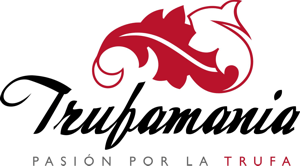DESERT TRUFFLES
What are desert truffles? “Desert truffles” is used to refer to edible hypogeous fungi (fungi that live entirely underground), which grow in arid and semi-arid areas of the Mediterranean region, members of the genera Delastria, Picoa, Terfezia, Tirmania, Mattirolomyces, Loculotuber and Tuber.
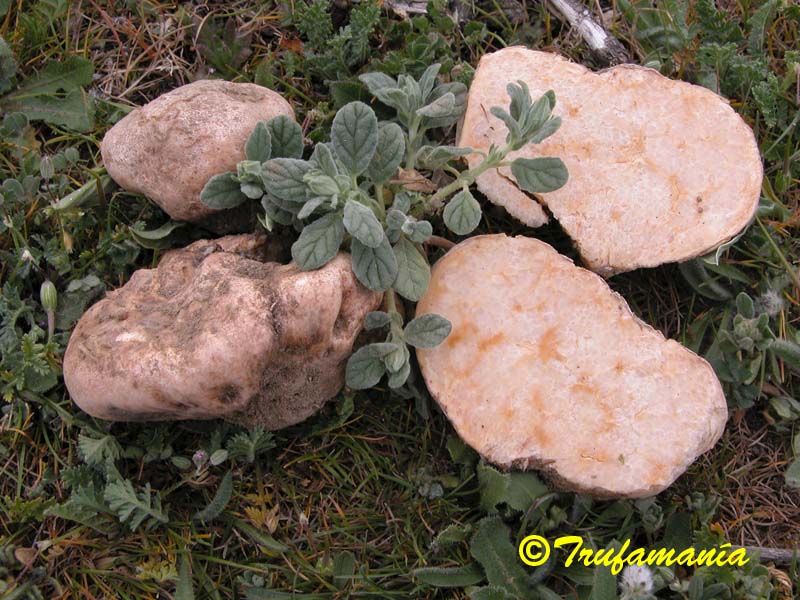
Terfezia claveryi
They are very appreciated in the Arab countries and we can find “desert truffles” in local market in Morocco with the common name of terfass (terfess or terfez). They are harvested in spring, except Delastria rosea and Tuber oligospermum wich mature in November and December. “desert truffles” grow naturally in Spain, except Tirmania genera, but only three species of Terfezia are commercially important: T. arenaria, T. claveryi and T. fanfani. Popular names are different depending on the region, the most frequent “turmas” in Murcia , “patatas de tierra”, “criadillas de tierra” in Extremadura, “papas crías” in Lanzarote and “criadas” in Fuerteventura. Besides these terfezias, Picoa species are consumed traditionally in Spain, but their small size makes them not suited to the market. Picoa receive the popular name of “negrillos” and “monegrillos”
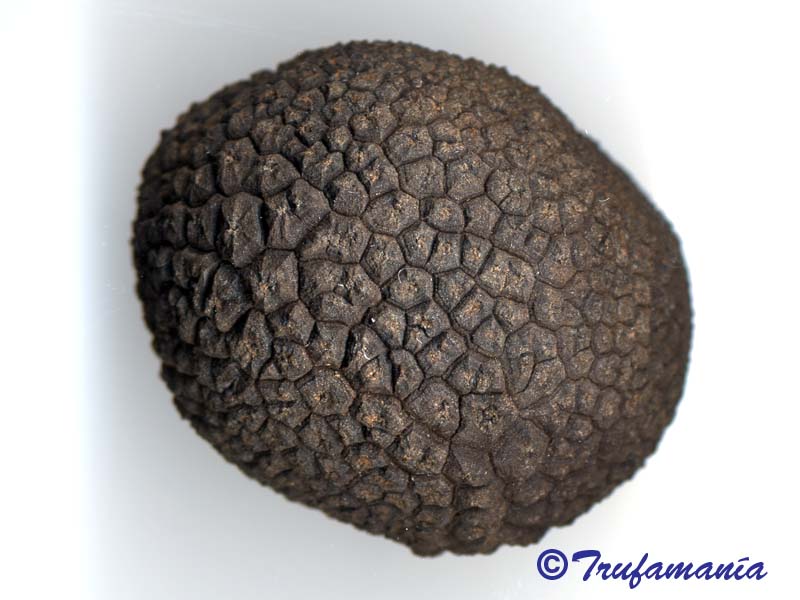
Picoa juniperi
Are they true truffles? The Romans knew “desert truffles” and called them “tuber” which in Latin means “hump”, “lump”, probably by the bulge they make in the ground when mature, and “truffle” comes from “tuber”. What is now known today as “true truffles”, Tuber species, were discovered later and they took the name of “truffle” because they grow underground. Nowadays “truffle” is a term used to name all hypogeous fungi. From this point of view, “desert truffles” can be considered truffles, but it is a commercial problem. They should not be called truffles because it leads to confusion. Gastronomically, “desert truffles” have nothing to do with black winter truffles, and its use in cooking is completely different. While true truffle is used to flavor dishes, “desert truffle” has no aroma at all and they taste like any other mushroom.
What are terfezias? Terfezia is the most frequent “desert truffle” in Spain. They grow below ground in symbiotic associations with the roots of some plants, usually Helianthemum.
Its name comes from the Arabic “terfez” which is used in North Africa to refer to all “desert truffles". Terfezias are known and appreciated since antiquity. The Greeks and Romans traded with them.
As terfezias reach good size, they begin to crack the surface of the ground, appearing as bumps, so you only need good eyesight to detect cracked bumps. Although growing in semi-arid regions, terfezias need plenty of rain to develop. August-September and January-February rains are particularly beneficial.
Terfezia arenaria and Terfezia fanfani can be found in acid soils. Terfezia claveryi, Terfezia boudieri and Terfezia olbiensis grow in alkaline soils.
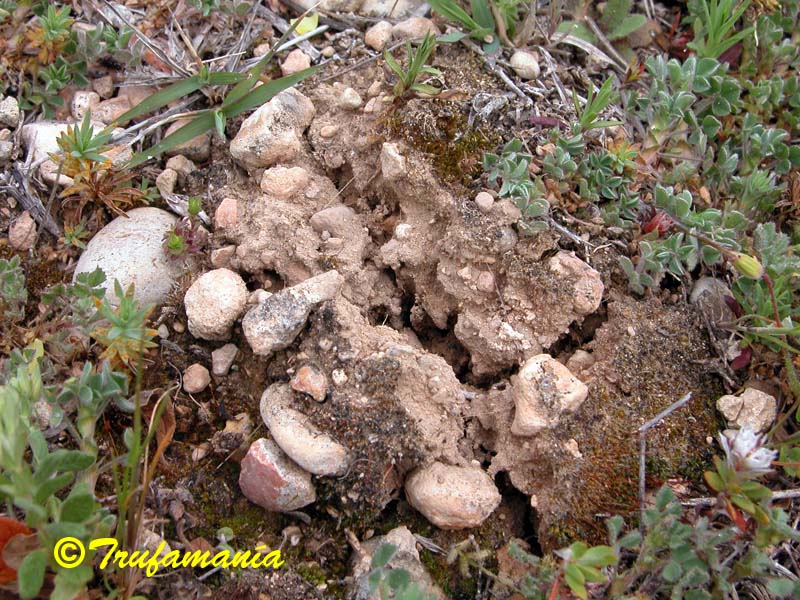
Grieta terfezia
NUTRITIONAL VALUE OF TERFEZIAS
Although desert truffles are consumed mainly by tradition and for its pleasant taste, they have significant amounts of protein and very high amounts of antioxidants, that make them very interesting from a nutritional point of view. Its composition varies according to species and according to the study authors. The following table is a summary of these studies.
|
Composition for 100 grams of Terfezias:
|
|
Water ............................................ 73–78 g Carbohydrates .............................. 11–17 g Protein ............................................. 4–5 g Fat ................................................ 0,6–1,8 g Fiber ............................................ 1,4–2,6 g Ash (minerals) .............................. 0,8–1 g Ascorbic acid (vitamin C) .............. 0,4–1 g
|
TERFEZIA ALBIDA
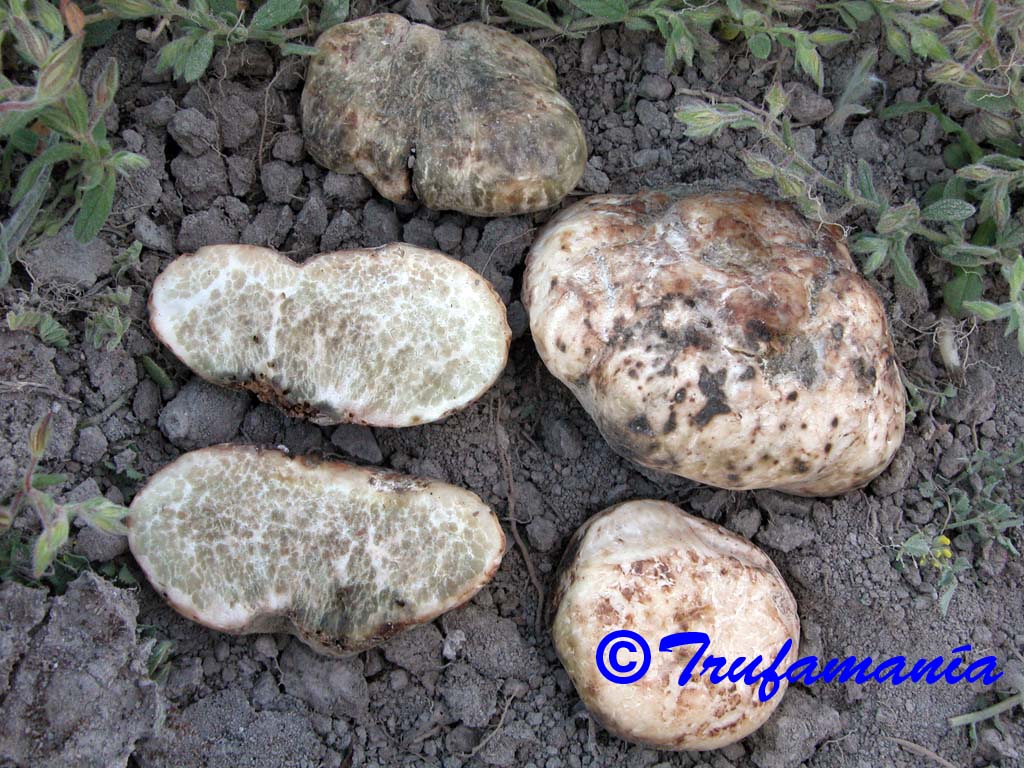
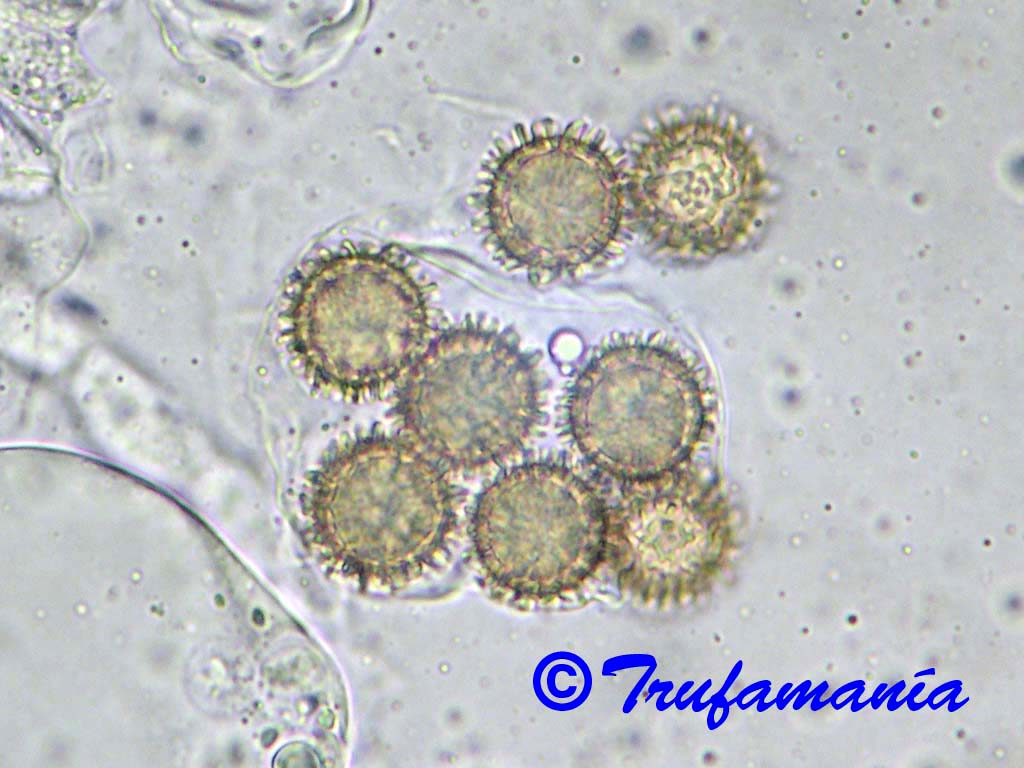
FULL DESCRIPTION Terfezia albida is a spring species that grows in alkaline soils. It is always associated with Helianthemum roots. So far we have only found them in Albacete and Murcia (Spain). White at first, becoming light beige, often black spots on the sun-exposed parts or where handled, greenish with age on injured areas, 2–4 cm across, 3–4 cm high, subglobose to turbinate, pulvinate. Gleba white at first, maturing to grayish green pockets of fertile tissue separated by whitish sterile veins. Spermatic odour, stronger in young specimens. Microscopy: Asci subglobose to ovate, 8-spored. Ascospores yellow ochre, spherical, 18–23 µm in diameter (including ornamentation), and decorated with conical, blunt, straight spines, 2–3 µm long, 1–2 µm wide at the base, sometimes connected to form a pseudo-reticulum.
TERFEZIA ARENARIA
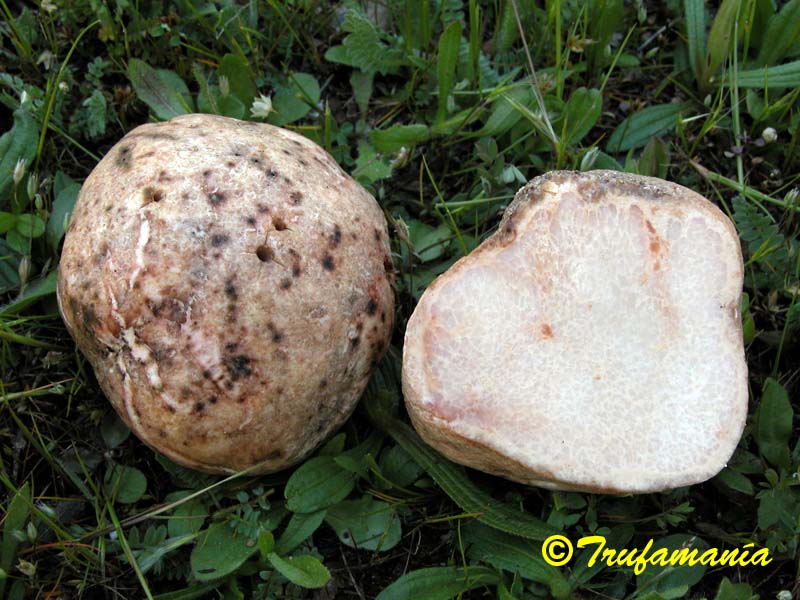
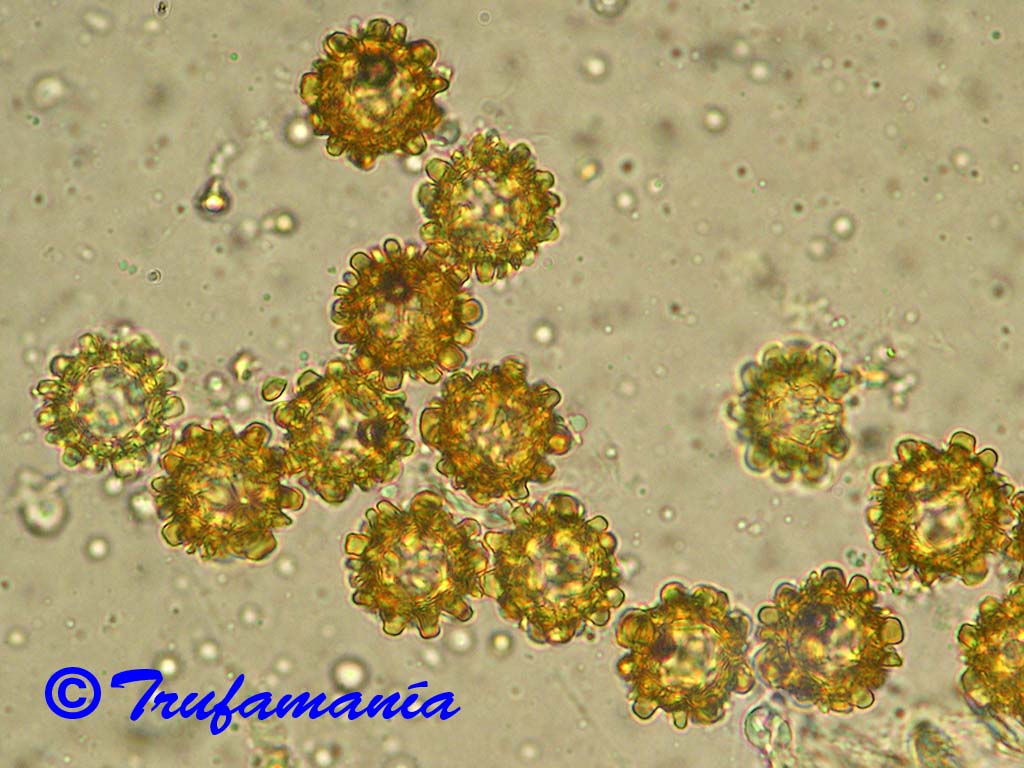
FULL DESCRIPTION Terfezia arenaria is a spring species that grows in acid, sandy and moist soil, poor in organic matter. It is always associated with Tuberaria guttata roots, “the mother”, “criadilla mother”. Terfezia arenaria is potato shaped, 3–10 cm in size, thick peridium, white at first, dark brown at maturity. The gleba is whitish at first, then becoming pink with pale veins. Weak smell and taste. Microscopy: asci globose to subglobose, 8-spored. Ascospores yellow ochre, spherical, 25–30 µm in diameter (including ornamentation), and decorated with truncated warts up to 7 µm tall.
Widely distributed in the Iberian Peninsula western half. Very common in grassland of Extremadura, where is called “criadilla de tierra" and “patata de tierra”. Gastronomically prized. Sold in fresh and canned in Extremadura, where is traditionally consumed.
TERFEZIA BOUDIERI
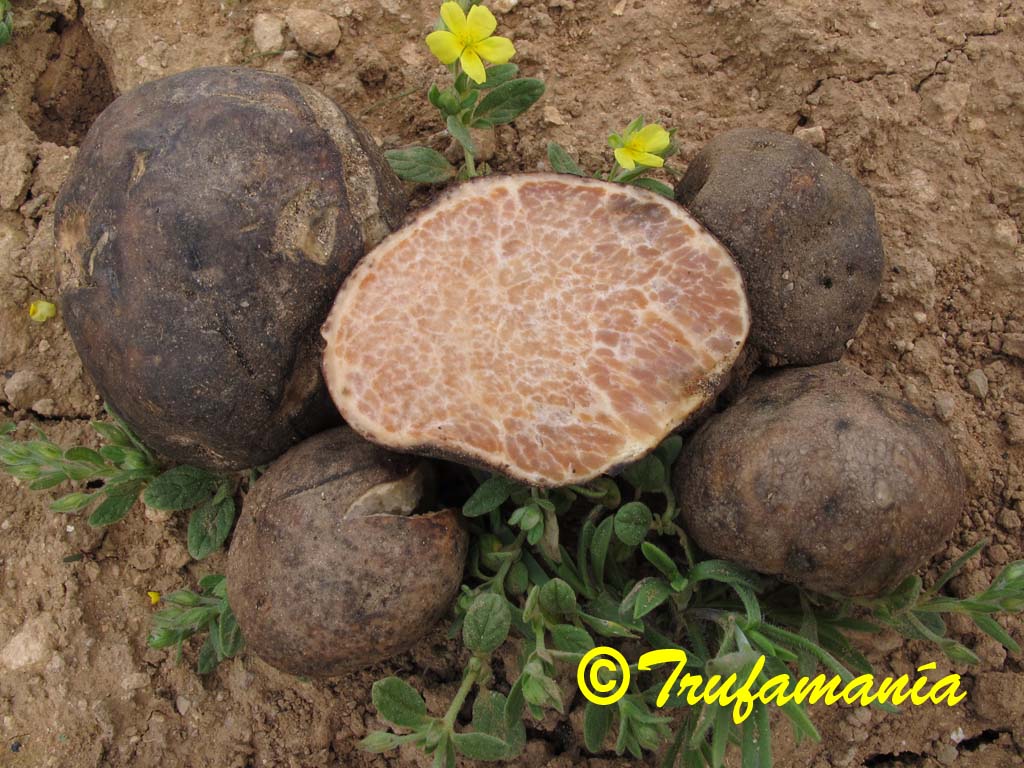
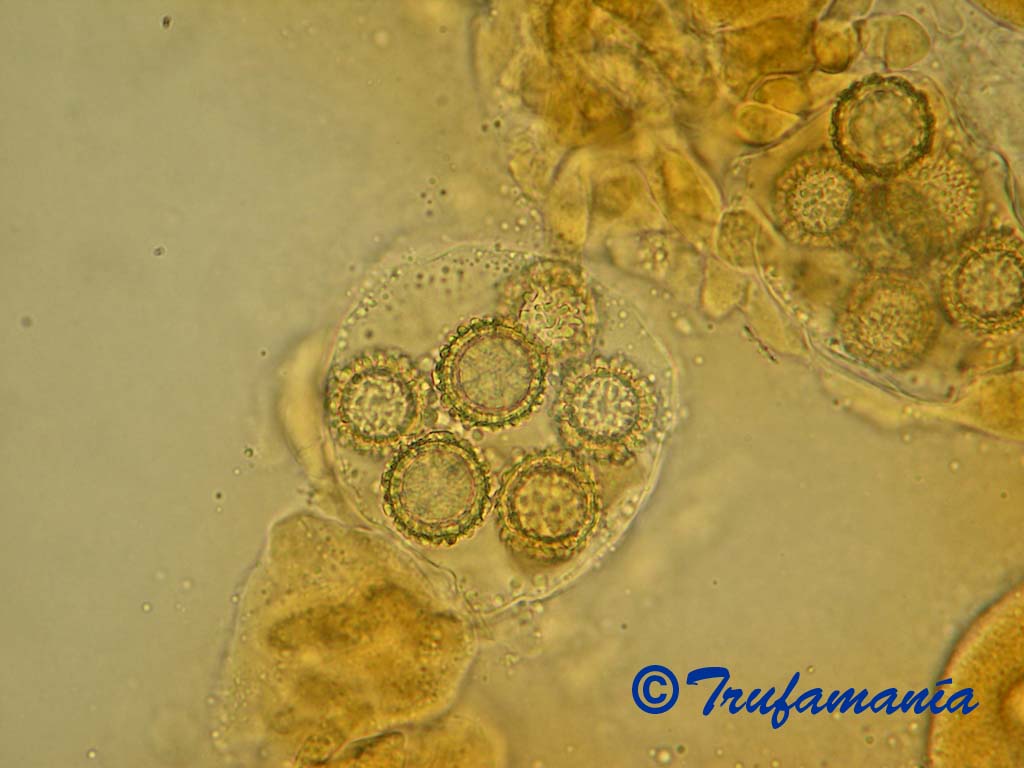
FULL DESCRIPTION Terfezia boudieri is a spring species that grows in alkaline soils. It is always associated with Helianthemum roots. We only have found them in the Canary Islands associated with Helianthemum canariense and in Murcia with Helianthemum almeriense. Terfezia boudieri is potato shaped, 2–6 cm in size. Thick peridium, dark brown and blackish at maturity. They never show such vivid colors as seen on the Terfezia claveryi. Specimens are often cracked. The gleba is pink salmon at maturity, with paler veins, but sometimes yellowish-orange in contact with air. Microscopy: asci subglobose, ovoid , something polymorphic, 4–6 spored. Ascospores yellow ochre, spherical, 20–25 µm in diameter (including ornamentation), and decorated with truncated and hemispheric warts up to 2 µm tall, and conical spines at maturity, interconnected by the base, forming a low reticulum, more apparent when specimens are young and warts are not developed.
We have harvested Terfezia boudieri together with Terfezia claveryi and Picoa lefebvrei, sharing habitat and maturing time.
TERFEZIA CANARIENSIS
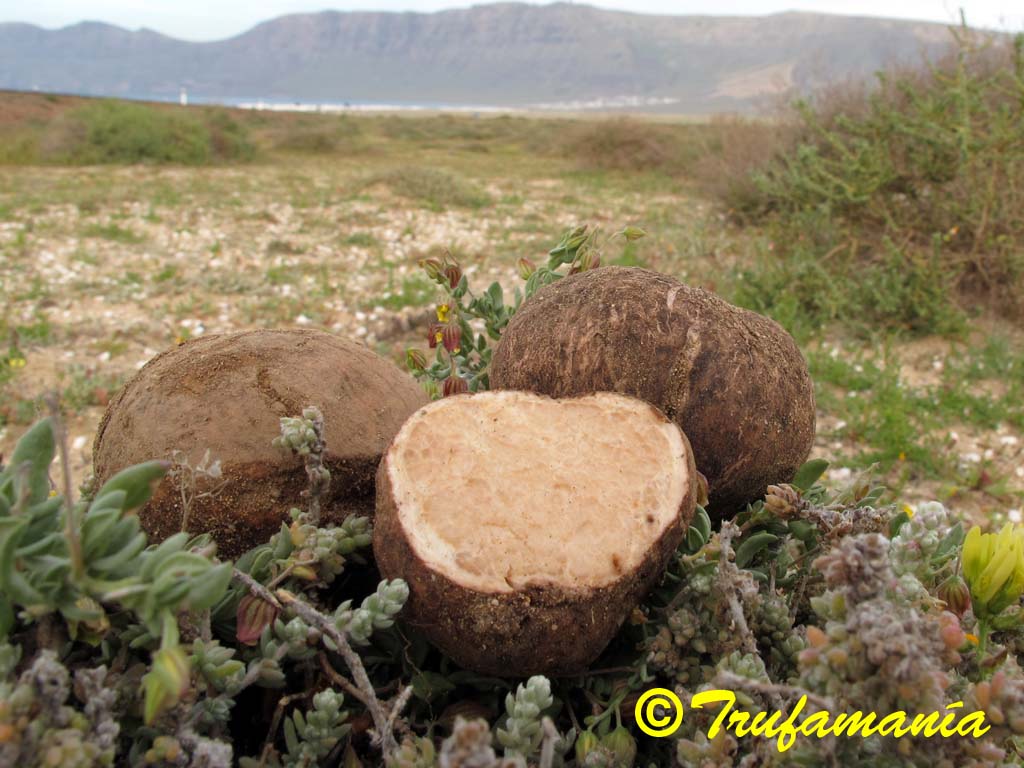
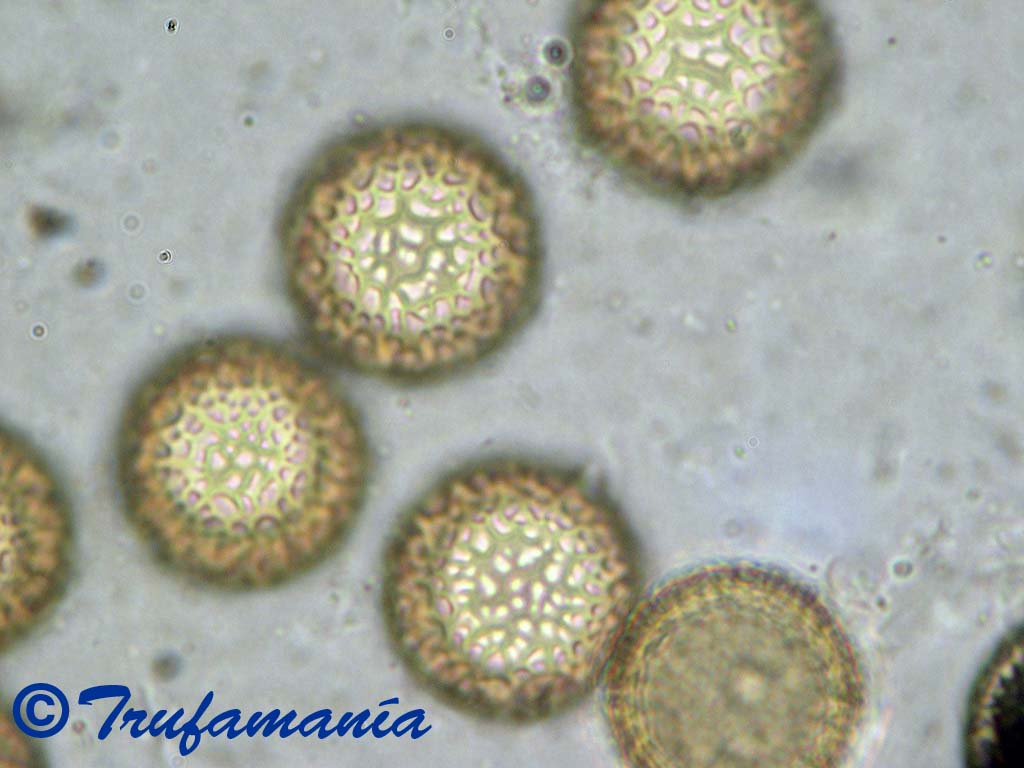
FULL DESCRIPTION Terfezia canariensis is a spring species that grows in alkaline soils. It is always associated with Helianthemum canariense roots. So far we have only found them in in the Canary Islands, in calcareous, clayey or sandy soils. Terfezia canariensis has been historically mistaken for Terfezia claveryi, but molecular and microscopic studies, enabled us to clearly distinguish both species.
TERFEZIA CISTOPHILA
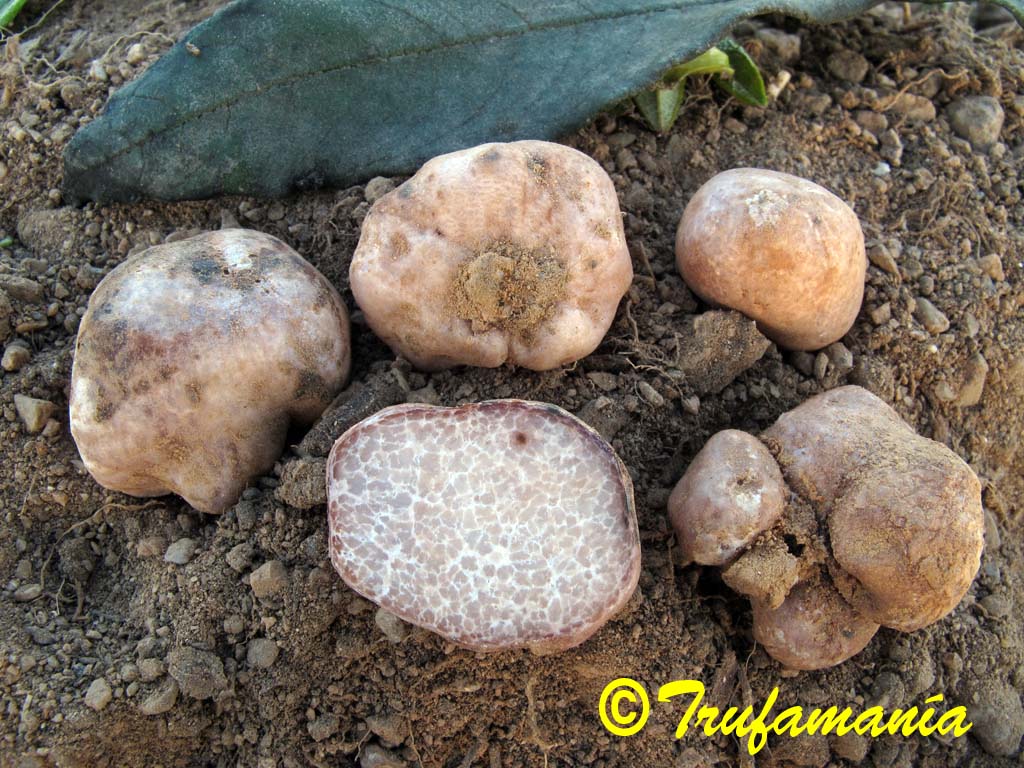
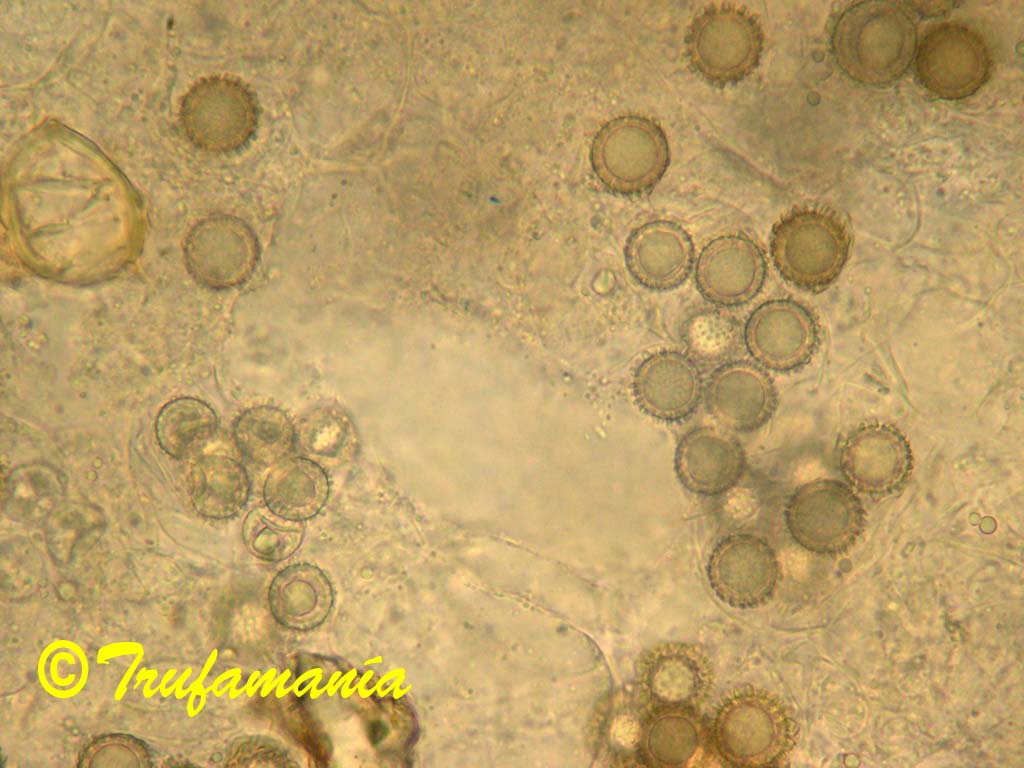
FULL DESCRIPTION Terfezia cistophila is a spring species that grows in acid soils, associated with Cistus spp. So far we have only found them in Extremadura (Spain) and Greece. Ascomata 0,5 –2 cm in size, subglobose, light beige at first, becoming dark reddish brown, with black spots. Gleba whitish with greyish pockets at first, maturing to light ochre, whitish sterile veins. Spermatic odour, stronger in young specimens. Microscopy: Asci subglobose to ovate, 8-spored. Ascospores yellow ochre, globose, 17–20 µm in diameter (including ornamentation), and ornamented with conical, separate, pointed, sometimes truncated spines, 1,5 –2,5 µm long, 1 µm wide at the base.
TERFEZIA CLAVERYI
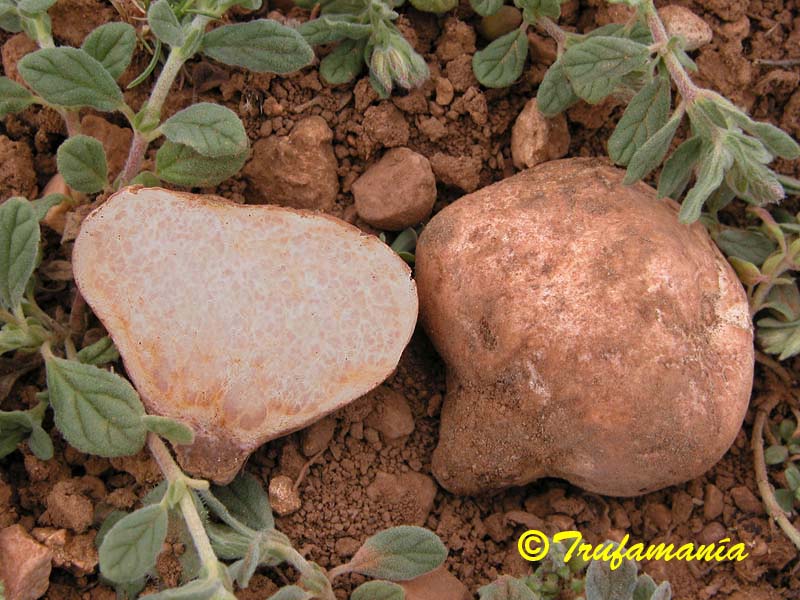
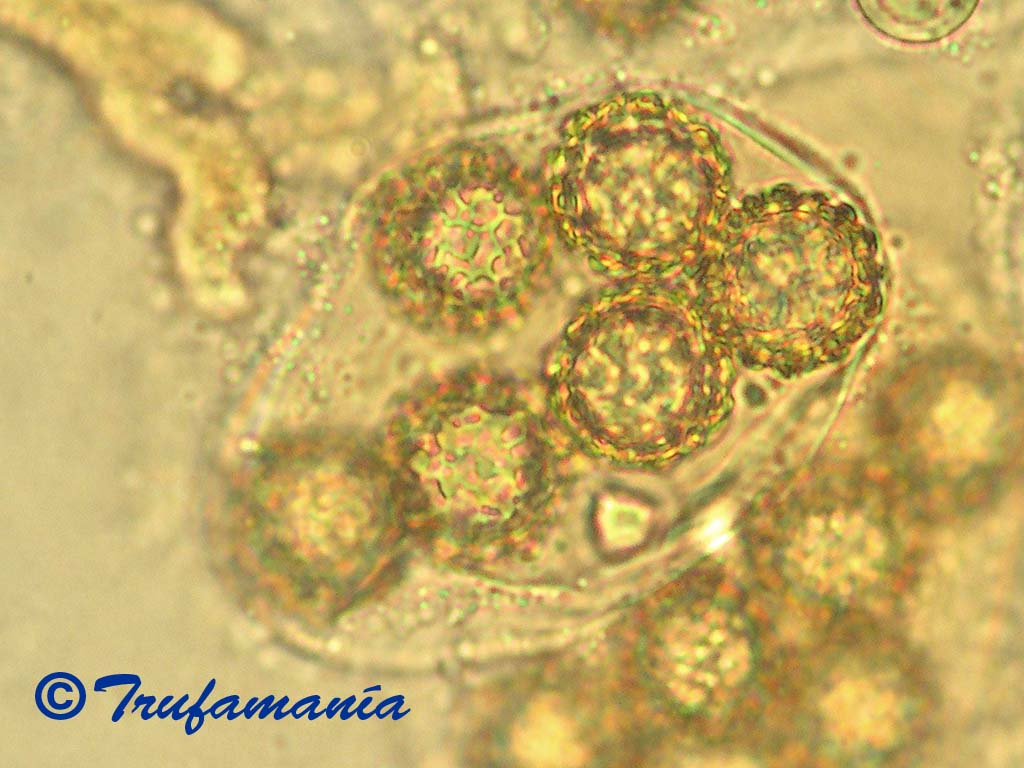
FULL DESCRIPTION Terfezia claveryi is a spring species that grows in alkaline soils. It is always associated with Helianthemum spp. Widely distributed in the eastern half of the Iberian Peninsula. Terfezia claveryi is potato shaped, but more irregular than T. arenaria because grows in more compact soils, with flattened and pyriform shapes and tapered, sterile base, 3–12 cm in size, thick peridium, dark reddish brown at maturity. Gleba is whitish at first, then becoming pink salmon with paler veins, but sometimes yellowish-brown in contact with air. Microscopy: asci globose to ovoid, 8-spored. Ascospores yellow ochre, spherical, 18–21 µm in diameter (including ornamentation), and decorated with hemispheric warts up to 2 µm tall and 2 µm wide, forming a well-defined reticulum, more apparent when warts are lower.
T. claveryi are popularly eaten in Murcia, where are called “turmas”, and in Albacete. Gastronomically prized, more tasty than T. arenaria.
TERFEZIA ELIOCROCAE
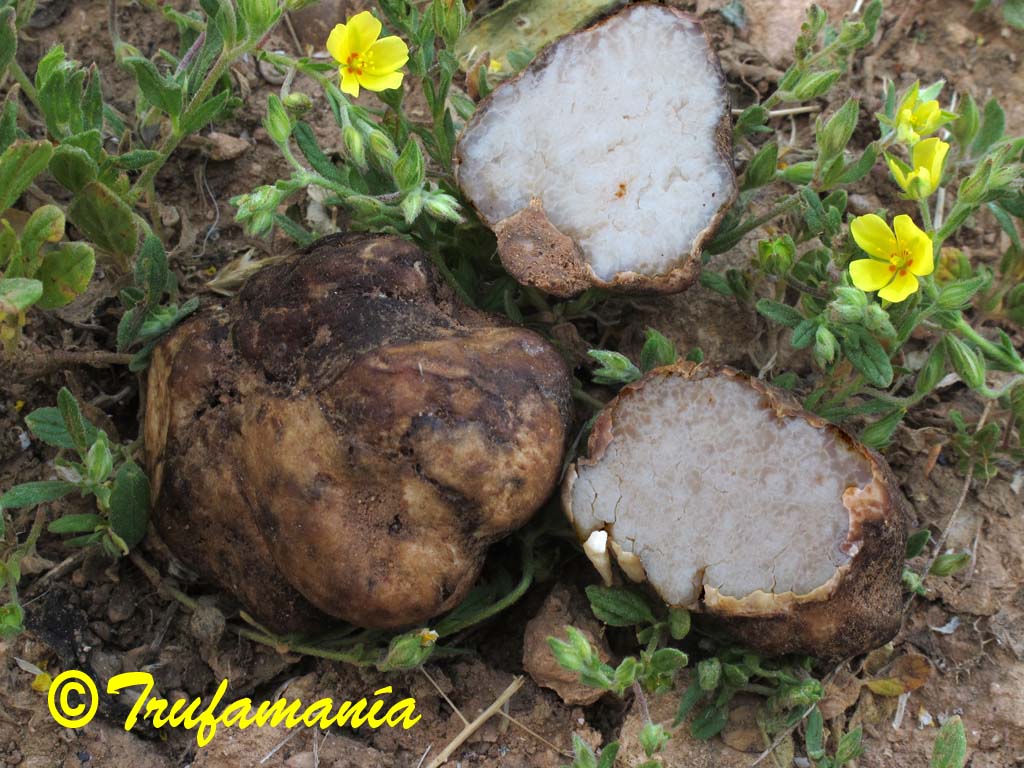
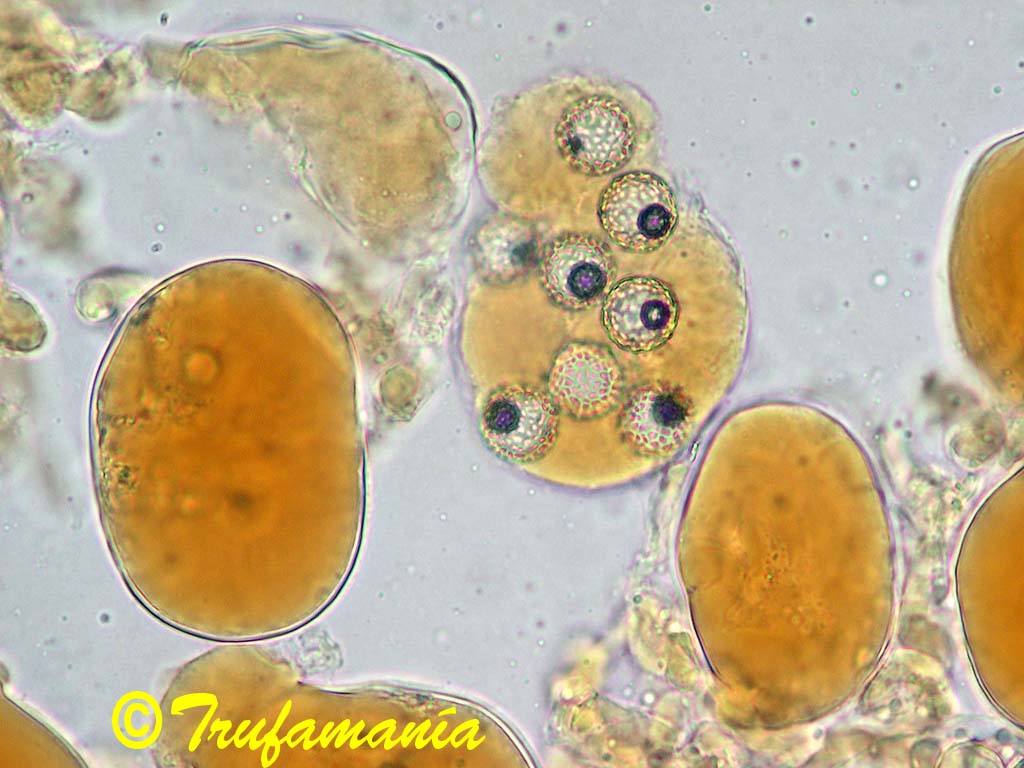
FULL DESCRIPTION Terfezia eliocrocae is a spring species that grows in alkaline soils. It is always associated with Helianthemum spp. So far we have only found them in Albacete and Murcia (Spain). Size 3–7 cm. Gleba white and friable. Odour faint, no distinctive.Microscopy: asci pyriform with 6–8 globose spores 16–18 µm, including ornament, reticulated.
TERFEZIA EXTREMADURENSIS
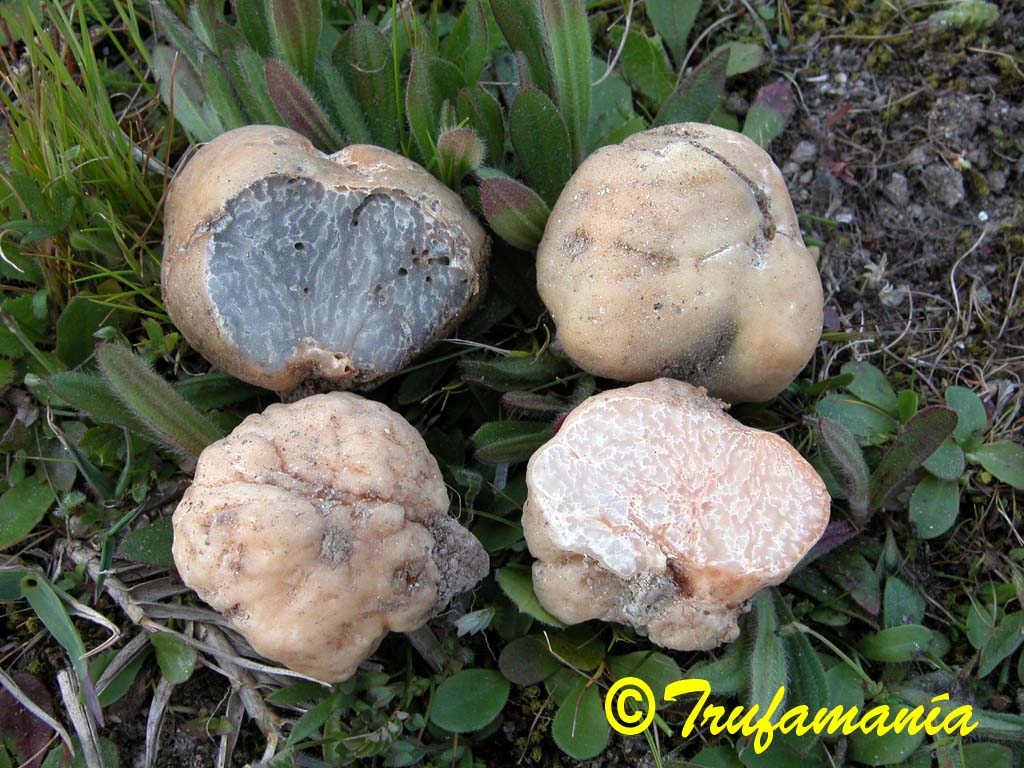
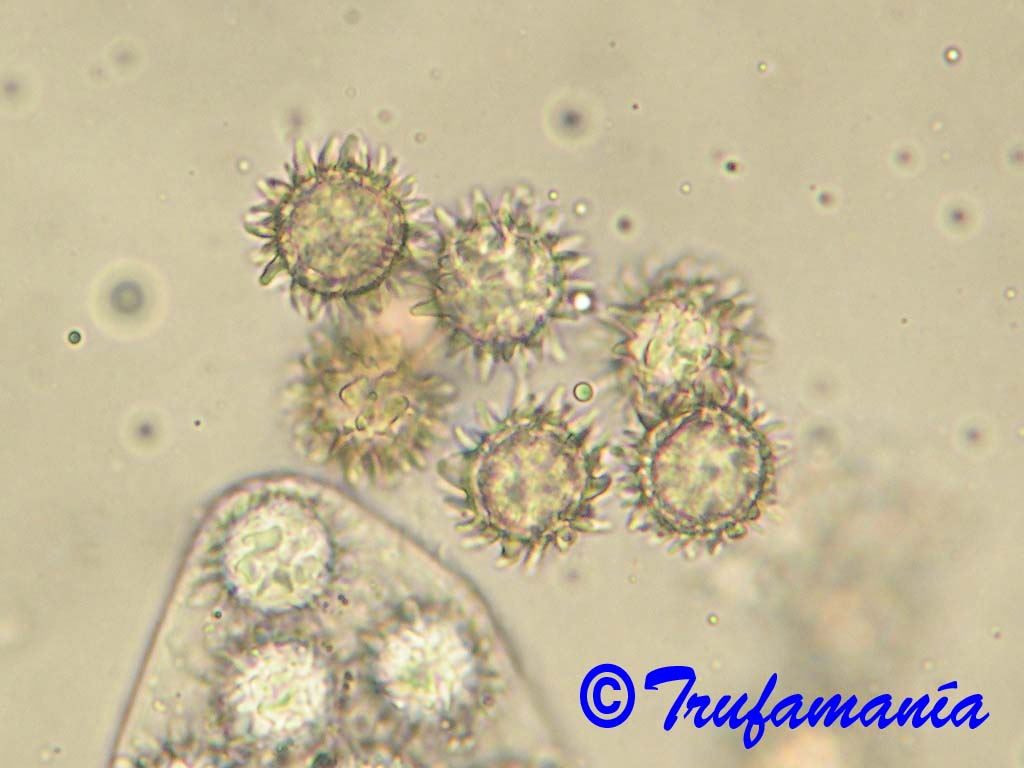
FULL DESCRIPTION Terfezia extremadurensis is also a spring species, but earlier than T. fanfani and can be found in January. It grows in acid soils, sandy soils. It is associated with Tuberaria guttata roots. Cream colour at first, becoming pale ochre. The gleba is whitish at first, greenish gray at maturity, marbled with thin, white, meandering veins. Often with small holes indicating mycophagous activity. Weak smell and taste. Microscopy: asci subglobose, 8-spored. Ascospores yellow ochre, spherical, 21–27 µm in diameter (including ornamentation), and decorated with conical, blunt, thick spines, sometimes truncated, sometimes finger-like, often joined at the base, 3–4(–5) µm long, 1–3 µm wide at the base. Widely distributed in the Iberian Peninsula western half. Very common in Extremadura pastures, where is called “criadilla de tierra", “patata de tierra” and “blanquilla”.
TERFEZIA FANFANI
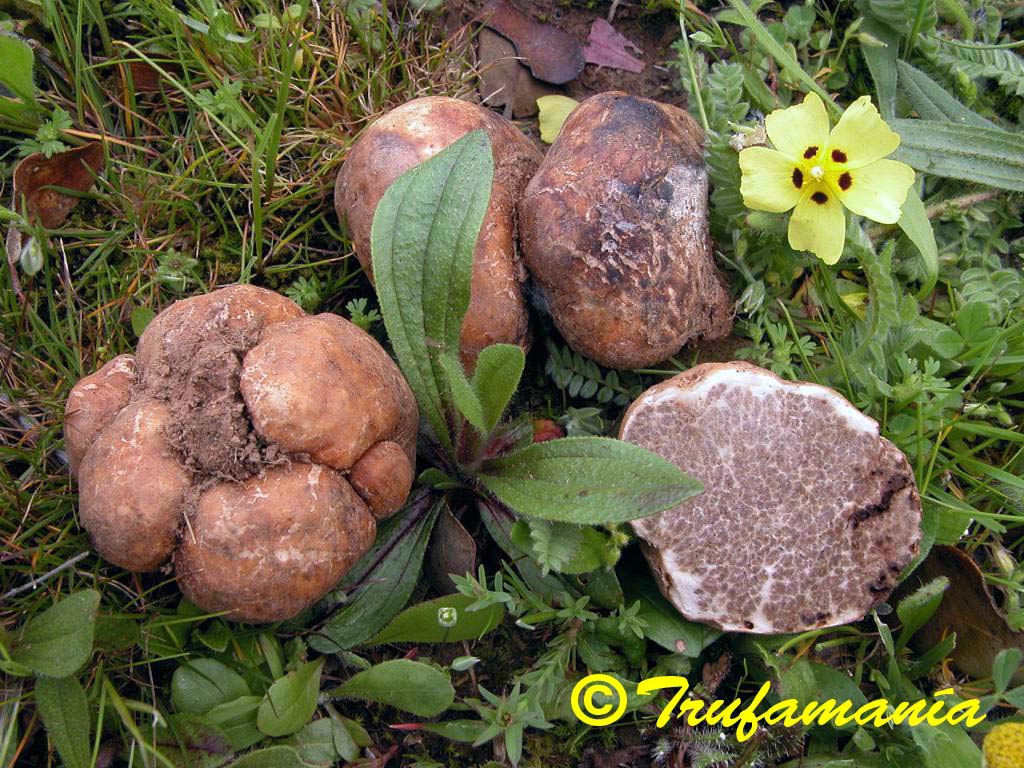
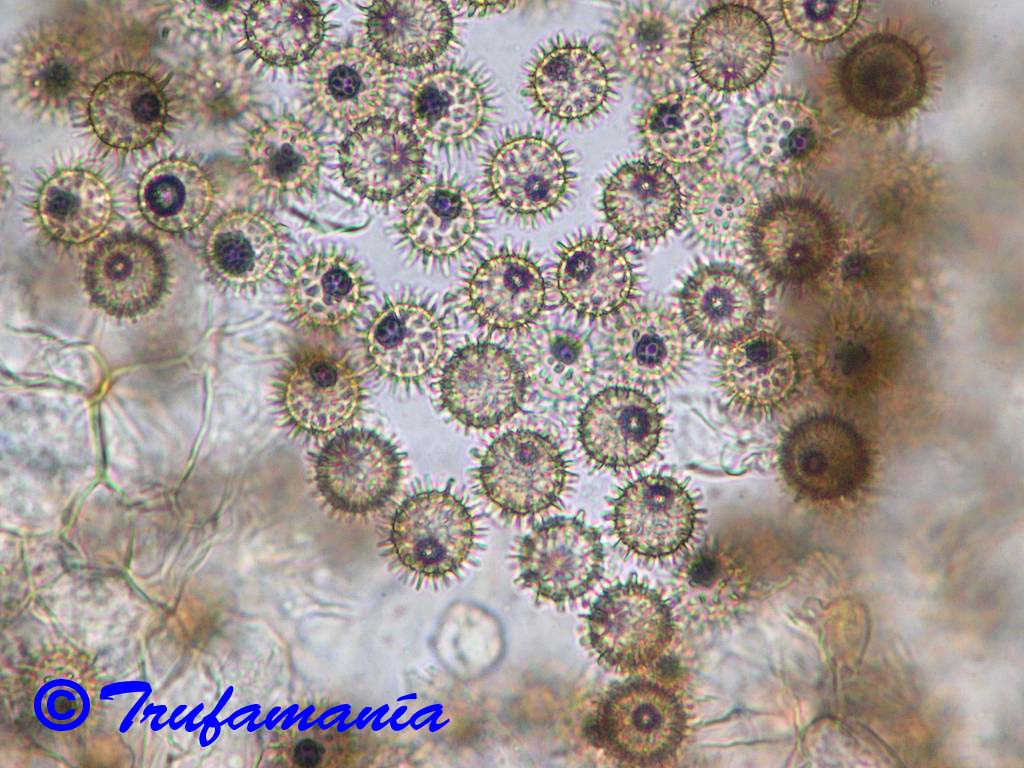
FULL DESCRIPTION Terfezia fanfani is also a spring species, but earlier than T. arenaria and can be found in January. It grows in acid soils, sandy or more compact soils. It is associated with Tuberaria guttata roots. Its appearance is similar to T. arenaria, but smaller and more reddish. Thin and reddish peridium from the beginning, a little rough. The gleba is whitish at first, then becoming greenish gray with whitish veins. Weak smell and taste. Microscopy: asci subglobose, 8-spored. Ascospores yellow ochre, spherical, 19–22 µm in diameter (including ornamentation), and decorated with conical spines, very sharp, isolated, up to 5 μm tall. Widely distributed in the Iberian Peninsula western half. Very common in Extremadura pastures, where is called “criadilla de tierra", “patata de tierra” and “rojilla”. Gastronomically prized.
TERFEZIA GRISEA
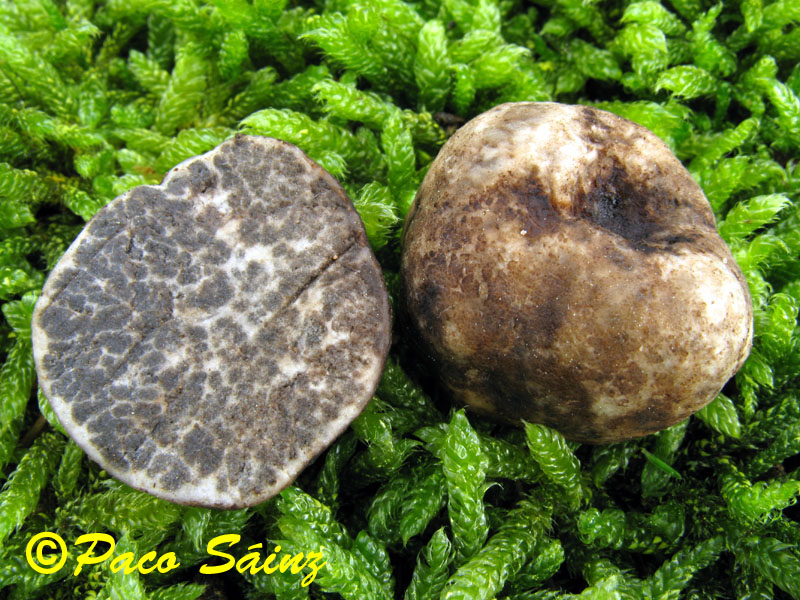
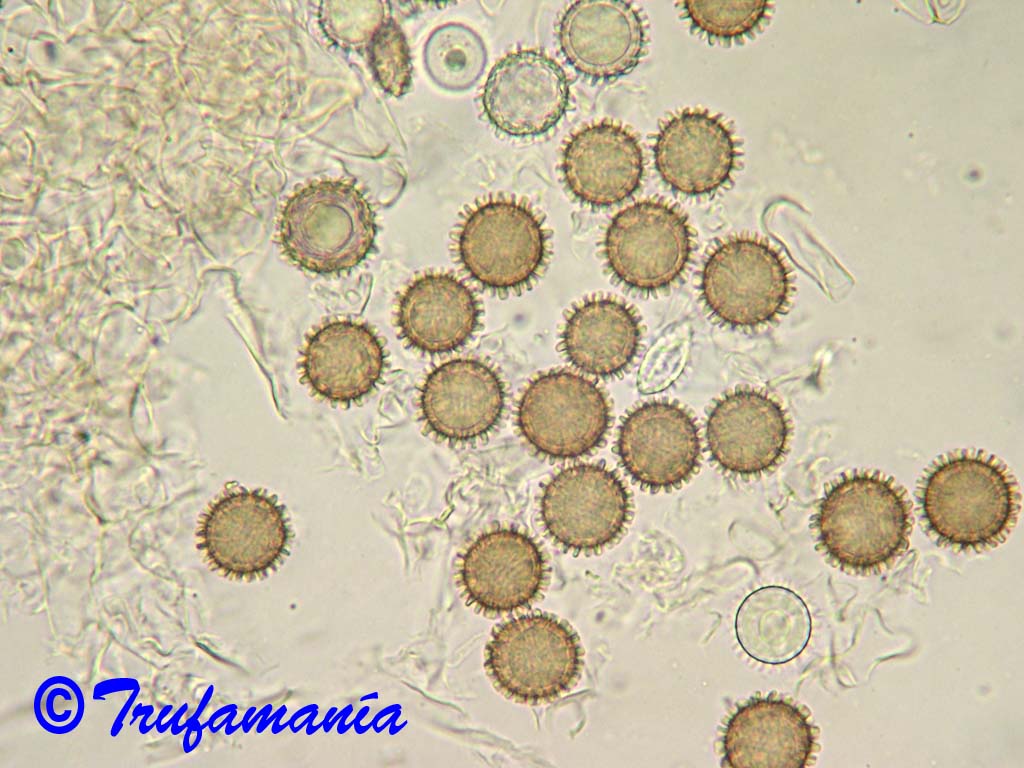
FULL DESCRIPTION Terfezia grisea is a spring species that grows in alkaline, sandy soils, associated with Helianthemum spp. Ascomata 1 –2,5 cm in size, subglobose, pale rusty at first, becoming brown, rusty or ochraceous brownish. Gleba whitish with greyish pockets at first, maturing to blackish gray pockets of fertile tissue separated by whitish, sterile veins. Microscopy: Asci subglobose to ovate, 8-spored. Ascospores yellow ochre, globose, 19–21 µm in diameter (including ornamentation), and ornamented with conical, sometimes truncated, separate, blunt spines, 2 –3 µm long, 1–2 µm wide at the base.
TERFEZIA OLBIENSIS
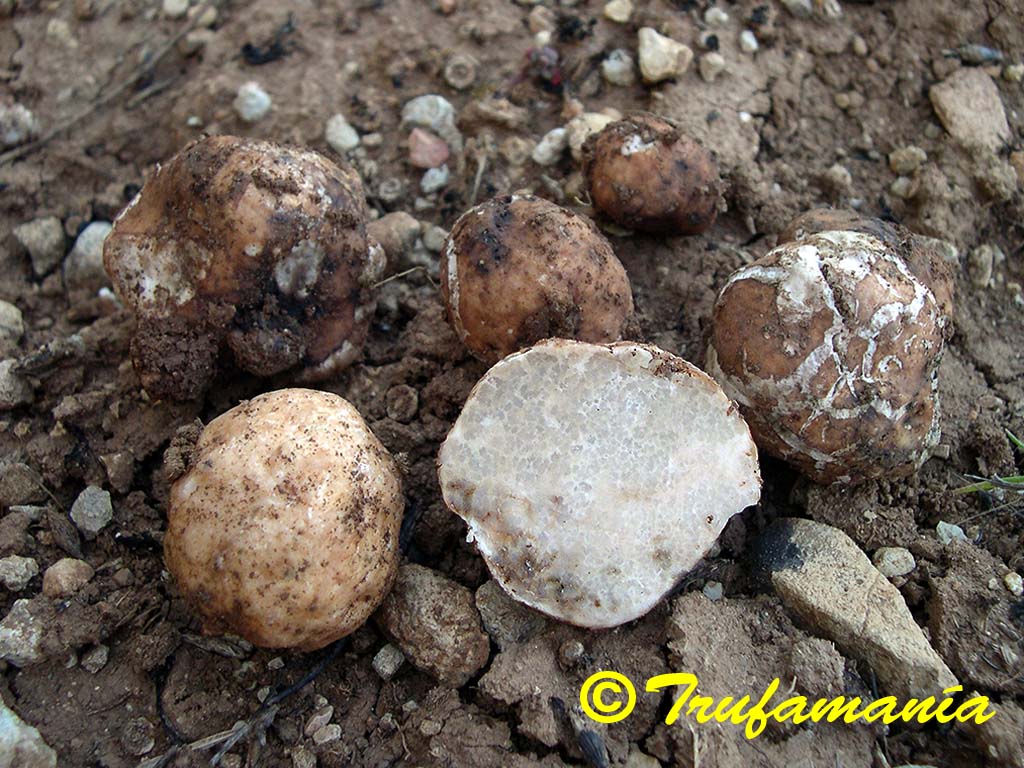
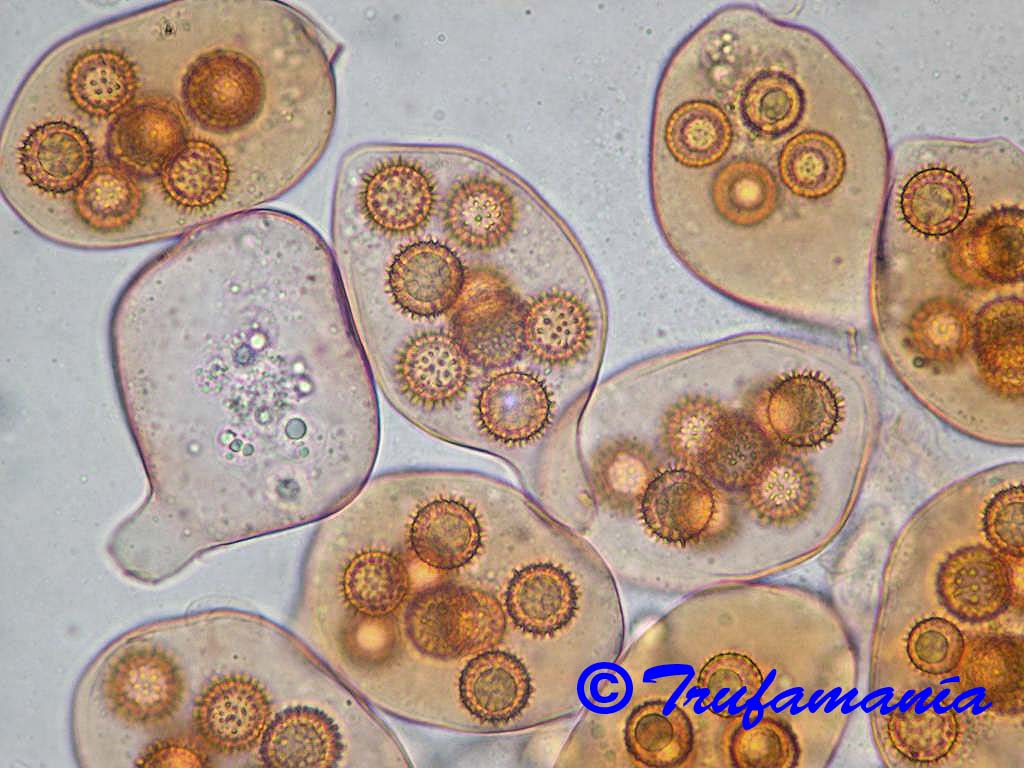
FULL DESCRIPTION Terfezia olbiensis is a winter-spring species associated with pines and holm oaks roots, without the presence of Helianthemum. It's a little known Terfezia, often mistaken with Terfezia leptoderma, and which some authors regard as synonymous, but they are clearly differentiated by their different ecology and microscopy. There is little data on their distribution. We have found them in Murcia and Albacete. Terfezia olbiensis is globose shaped, fairly regular, 2–5 cm in size. Thin peridium, whitish at first, then becoming brown and blackens with handling. The gleba is pinkish gray , then becoming olive green with pinkish white veins. Microscopy: asci subglobose to ovoid, 8-spored. Ascospores ochre, spherical, 16–19 µm in diameter (including ornamentation), and decorated with conical spine, isolated, of 1–2 μm tall (shorter and less thick spines than Terfezia fanfani).
TIRMANIA NIVEA
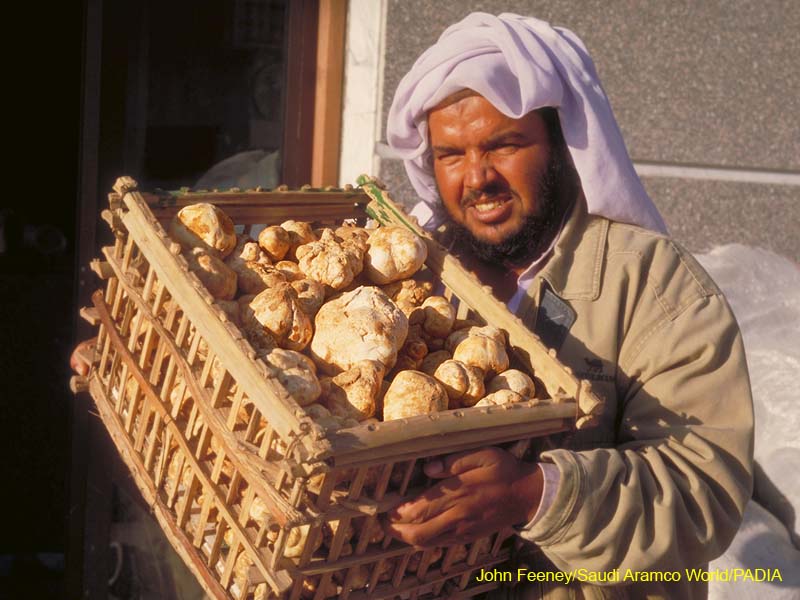
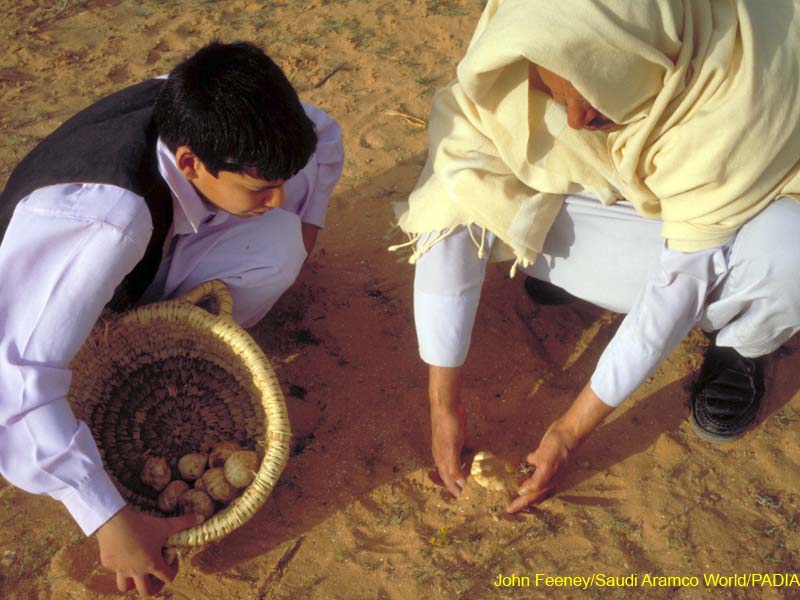
Tirmania nivea is the real “truffle desert” and the most appreciated in Arab countries. We can found them in markets from January to April. They grows naturally in North Africa deserts from Morocco to Iraq. “Zubaidi” is their common name, but also known as “fagaa”, that is the collective name for all “desert truffles” in the Persian Gulf Countries, and “terfez” in Morocco.
Tirmania nivea, known and consumed since the Ancient Age, would be the truffle so prized by Greeks and Romans. Juvenal, Roman poet, wrote in his satires: “Keep your grain, O Libya!…unyoke your oxen if only you send truffles!”. According to Elinoar Shavit and Tom Volk, Tirmania could be the Israelites manna in the desert.
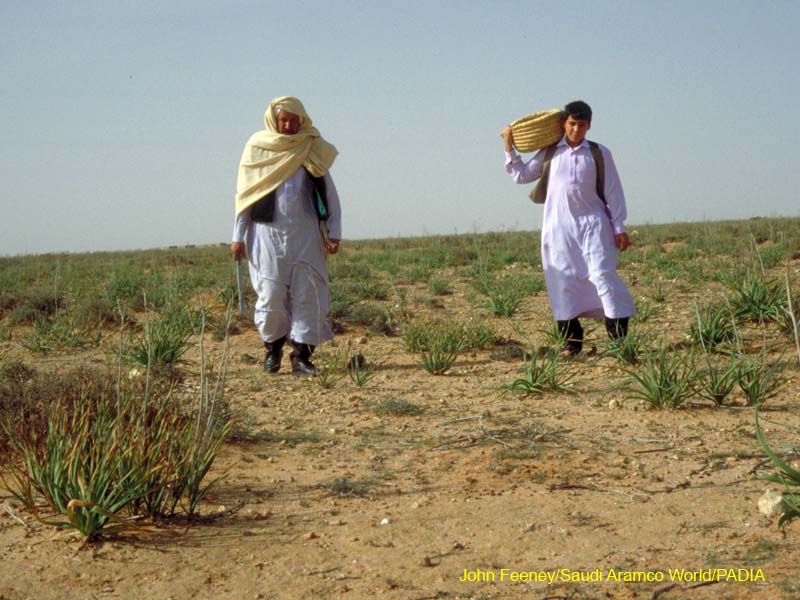 Tirmania nivea habitat |
They are white when they are pulled from the earth, but in contact with air turns yellowish. They are very fleshy and reach a size greater than 10 cm in diameter. The gleba is whitish or pale pink with pale veins. Weak smell and taste.
Microscopy: amyloid asci and smooth spores.
Tirmania nivea grows under desert sand, associated with Helianthemum roots.
Its price, in Arab markets, rarely exceeds € 40 per kg, but varies greatly with the harvest. In very dry years, the “white truffle desert” can reach € 200 per kg.
Some “truffle desert” dealers are trying to sell Tirmania nivea as Italian white truffle (Tuber magnatum), because of their similar appearance and they can reach exorbitant prices that have nothing to do with its gastronomic value.
PICOA JUNIPERI
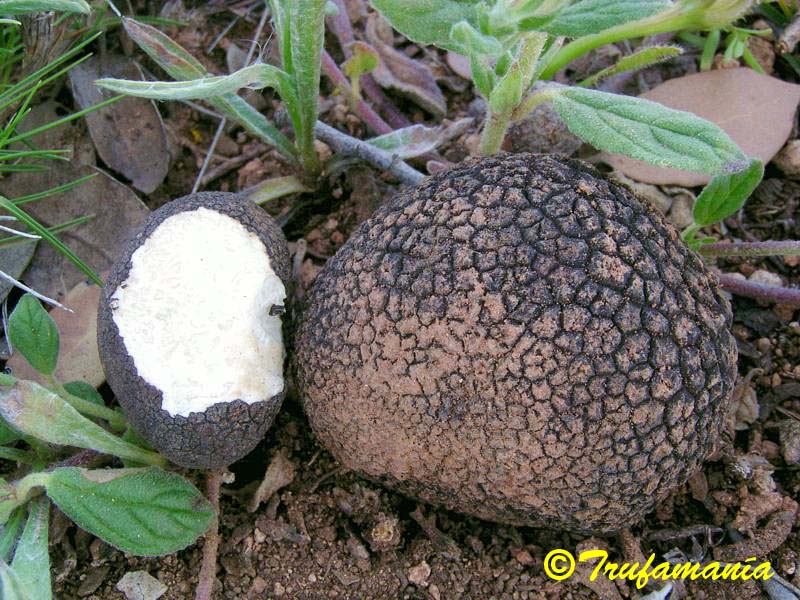
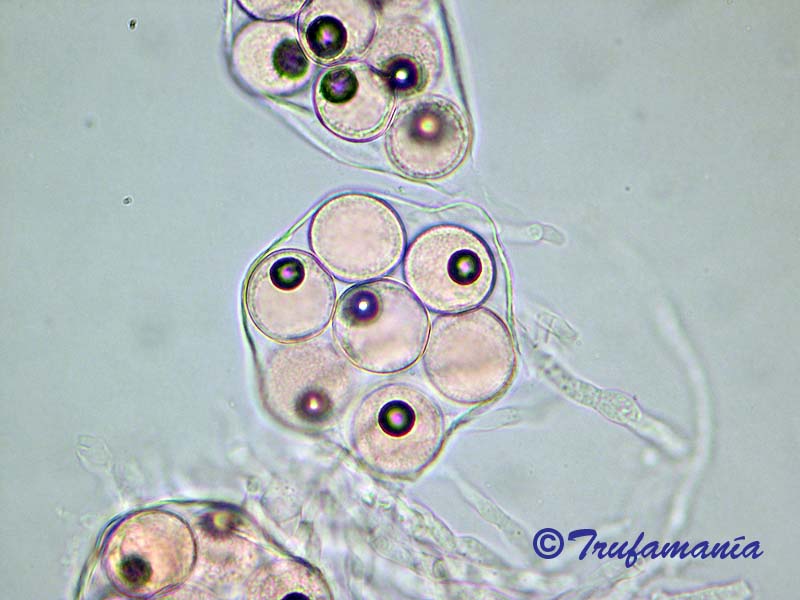
Picoa juniperi is a spring species associated with Helianthemum roots and sharing habitat with T. claveryi, but with a wide distribution area. We have found them in Albacete, Madrid and Teruel, but it is cited throughout Spain with calcareous soils, although some of them have been cited afterwards as Picoa lefevrei.
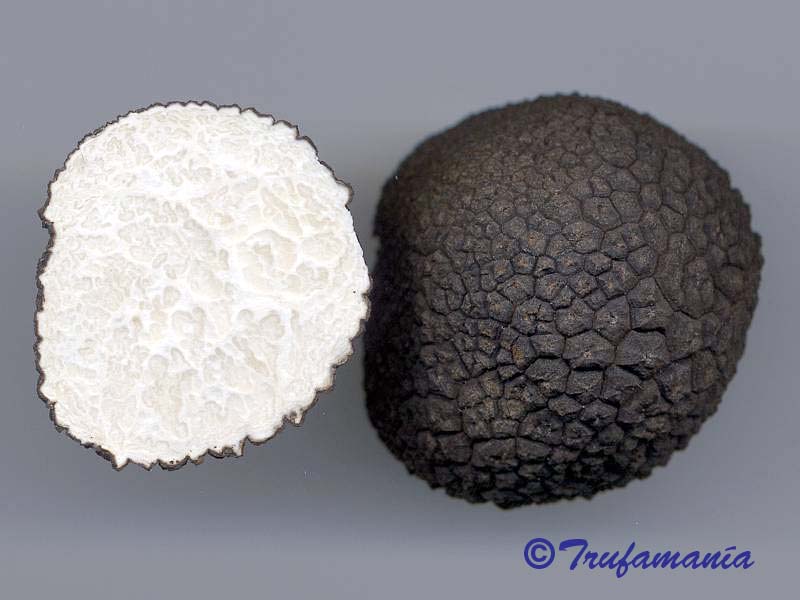 Picoa juniperi |
We think that Picoa juniperi and Picoa lefebvrei are the same species.
Ascoma: subglobose, fairly regular, 1–3 (5) cm in size, black and warted. Peridium covered with black polygonal warts, flattened, having a depression at their summit. These warts are not always as small as described by some publications (we have seen warts up to 4 mm wide) and these Picoas look like summer truffles. The gleba is white with white veins. Sweet smell, coconut and pleasant taste. Microscopy: asci subglobose, with 6–8 spores. Ascospores: hyaline, spherical (some slightly ellipsoid), with a large guttule, smooth, then becoming dotted, 22–28 (32) x 22–25 (28) µm, (Q=1,00–1,16).
Common names are: “chivatos de las turmas” in Murcia, “negrillos” and “monegrillos” in Albacete.
Picoas are consumed together with Terfezias, but its small size makes them not suited to the market.
PICOA LEFEBVREI
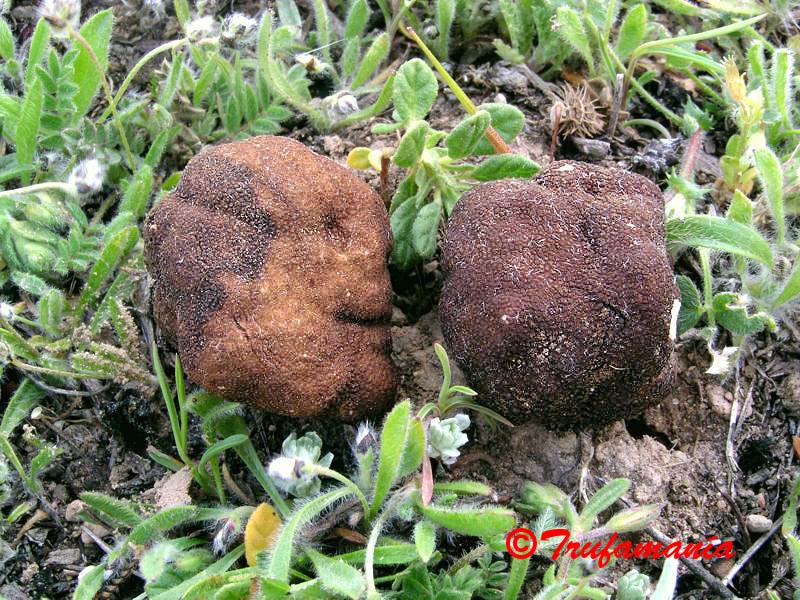
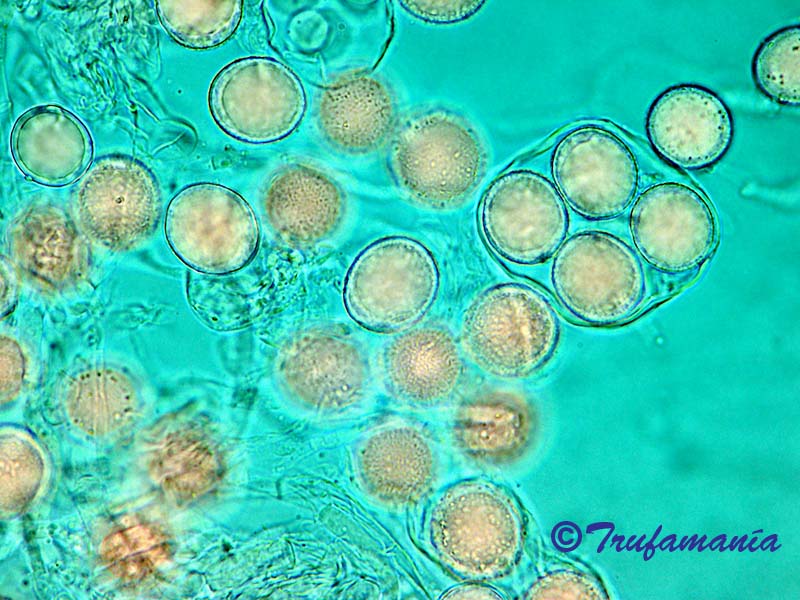
Picoa lefebvrei is a spring species associated with Helianthemum roots and sharing habitat with T. claveryi, but with a wide distribution area. We have found them in Albacete and Murcia. There is little data on their distribution because of their confusion with Picoa juniperi (we think they are the same species).
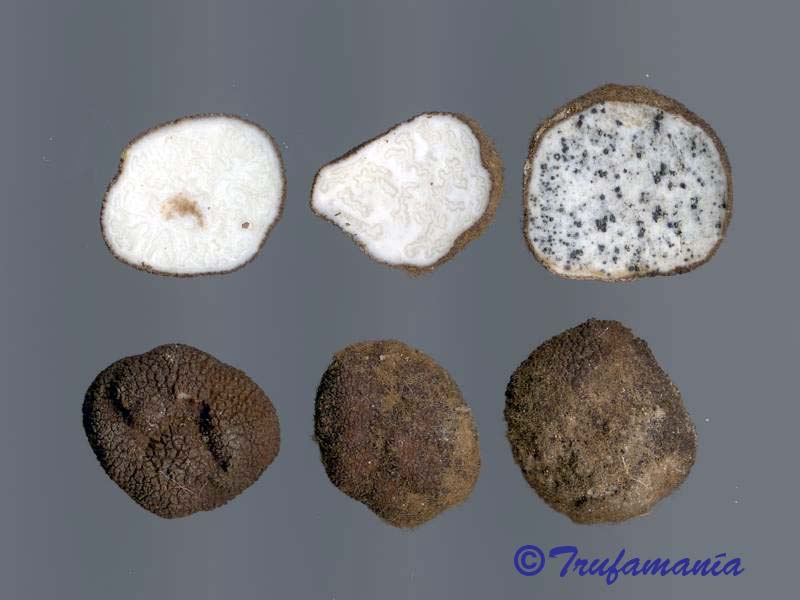 P. lefebvrei parasitized by Melanospora zobelii |
Ascoma: subglobose, and fairly irregular when several specimens grow together (that is the most frequent), 1–3 (5) cm in size. brown to black, sometimes with reddish tones, and warted. Peridium covered with very small brown polygonal warts, 1–2 mm wide, flattened, having a depression at their summit, and with more or less regular distribution. Then becoming dark brown to black at maturity. Young specimens are often coated with brown tomentum. The gleba is white with white veins. They are sometimes parasitized by Melanospora zobelii causing black dots in the gleba. Sweet smell, coconut and pleasant taste. Microscopy: asci subglobose, with 4–8 spores. Ascospores: hyaline, spherical (some slightly ellipsoid), with a large guttule, smooth, then becoming dotted, 20–28 x 19–24 µm (Q=1,00–1,27). I see them as Picoa juniperi spores. Peridium pseudoparenchymatous with brown hair, long (> 100 µm), septate, thick-walled (1 µm) and 8–11 μm wide.
Common names are: “chivatos de las turmas” in Murcia, “negrillos” and “monegrillos” in Albacete.
Picoas are consumed together with Terfezias, but its small size makes them not suited to the market.
TUBER GENNADII
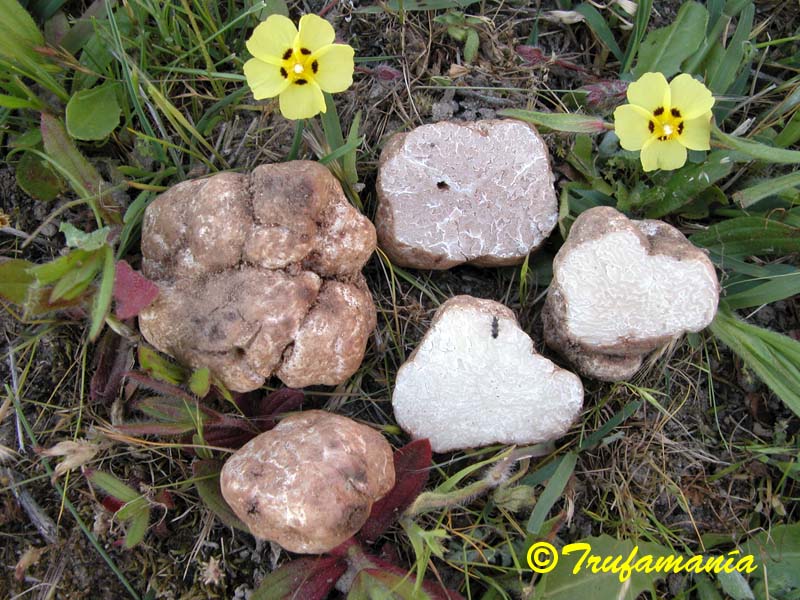
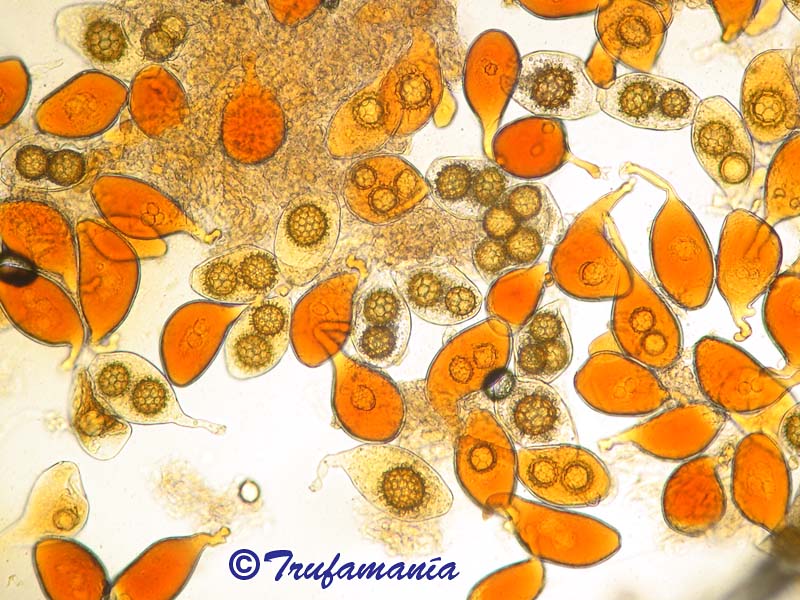
FULL DESCRIPTION Basionym: Terfezia gennadii Chatin 1896. Loculotuber gennadii is a spring species that grows in acid soils, associated with Tuberaria guttata roots and other Cistaceae, and sharing habitat with Terfezia spp. It's a little known Tuber, often mistaken with Tuber asa, and which some authors regard as synonymous, but they are clearly differentiated by their different microscopy. There is little data on their distribution because of their confusion with Tuber asa. We have found them in Extremadura, Madrid and Albacete. Ascoma: subglobose, lobed, deeply sulcate, 1–5 cm in size. Thin peridium, dirty white becoming ligt brown. The gleba is whitish at first, then becoming brown at maturity, marbled with thin white veins, and with small cavities. Odour characteristic and distinctive. Microscopy: asci ellipsoid to clavate, long stalked, more or less arranged among paraphyses in a hymenium, with 1–3 (4) spores. Ascospores: yellow brown, translucent, subglobose to broadly ellipsoid, ctitriform or eye-shaped, reticulate-alveolate, 28–40 x 27–40 µm, (Q=1,00–1,37). We found considerable variation in the form of spores in the various collections, some with very few eye-shaped spores.
The genus Loculotuber was created by the partially ordered arrangement of the asci and paraphyses. This character is also very variable and it is easier to see when the gleba has more cavities.
Very common in Extremadura pastures, where is called “cottage cheese". Gastronomically not prized.
TUBER MELOSPORUM
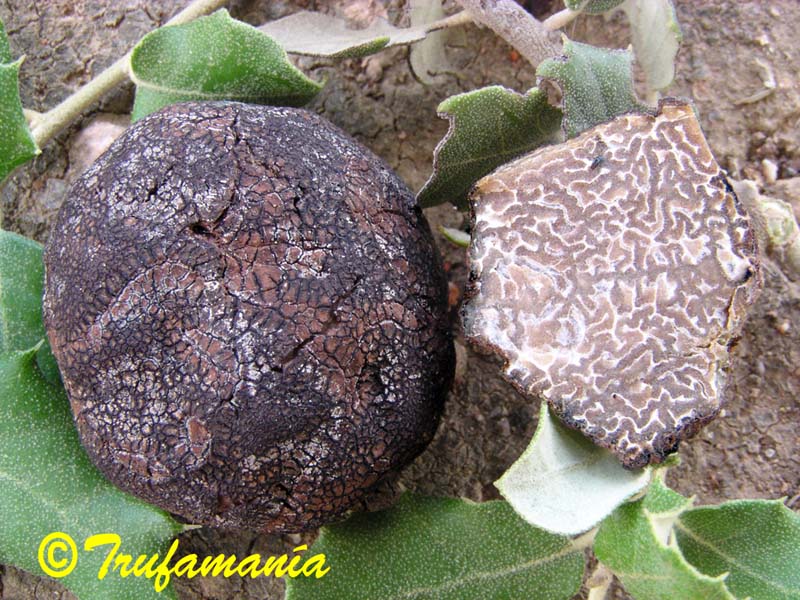
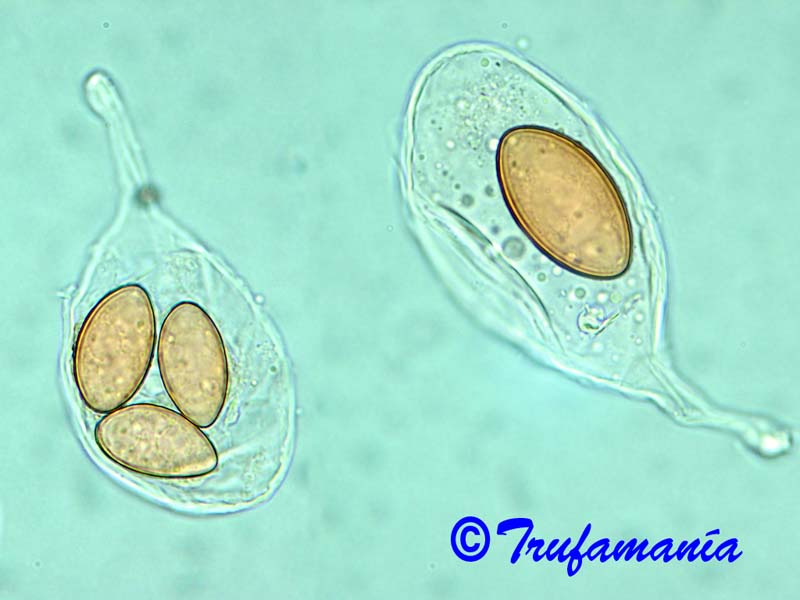
FULL DESCRIPTION Tuber melosporum is a Tuber species associated with Helianthemum spp. and Quercus ilex, in the original description by Moreno et al. -2000-, but they are also found under Pinus halepensis without the presence of Helianthemum spp. Ascoma: 1–3 cm in size. Peridium: dark brown to black, with reddish tones, covered with flattened irregular warts, with a cracked appearance. Gleba: brown, marbled with white and dark veins. Microscopy: Asci ovoid to pyriform, ellipsoid, elongated, 70–90 x 50–60 μm, with a long stalk up to 60 μm, with 1–4 (5) spores. Ascospores: 26–50(–58) x 17–30 µm, Q=1,24–1,82, size variable depending on number of spores in the ascus, ellipsoid, smooth, hyalines at first, yellow ochre at maturity. These spores have a very thick wall (2 μm). Peridium 150–250 µm thick, composed of agglutinated hyaline hyphae, interwoven, becoming pseudoparenchymatous and pigmented towards the surface. Notes: Very similar to Tuber rufum.
| Antonio Rodríguez trufamania@gmail.com antonio@trufamania.com |
